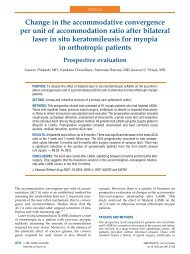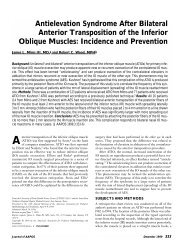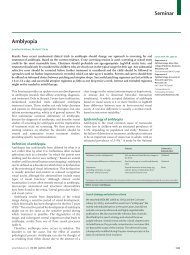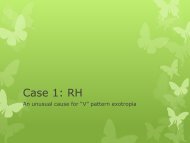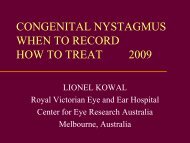What's new AAPOS 2008 - The Private Eye Clinic
What's new AAPOS 2008 - The Private Eye Clinic
What's new AAPOS 2008 - The Private Eye Clinic
You also want an ePaper? Increase the reach of your titles
YUMPU automatically turns print PDFs into web optimized ePapers that Google loves.
Verisyse intraocular lens implantation in a child with anisometropic amblyopia:<br />
four-year follow-up.<br />
Assil KK, Sturm JM, Chang SH.<br />
J Cataract Refract Surg. 2007 Nov;33(11):1985-6.<br />
A Verisyse phakic intraocular lens (pIOL) (AMO) was implanted in the eye of a 3-yearold<br />
child with unilateral high myopia and suspected dense amblyopia. Four years<br />
postoperatively, the Snellen visual acuity was 20/30 with a refraction of -1.00 -1.00 x 77<br />
and the endothelial cell density was 3262 cells/mm(2) compared with 3092 cells/mm(2)<br />
in the right eye. <strong>The</strong> Verisyse pIOL may be a treatment option to prevent dense<br />
amblyopia in children with highly myopic anisometropia.<br />
GLUED PATCHES FOR CHILDREN RESISTANT TO AMBLYOPIA OCCLUSION<br />
THERAPY<br />
A Case Report<br />
Shehla Rubab MD MCPS FCPS (Pak); Dana French BSc OC(C); Alex V Levin MD<br />
MHSc FRCSC<br />
Arch Ophthalmol <strong>2008</strong>;126(1):133-134<br />
This was a pilot study for a novel approach to poor compliance to occlusion therapy;<br />
specifically, cyanoacrylate glue applied to a patch to increase its adhesiveness so the<br />
child could not easily remove it. Dermabond Glue (Ethicon Inc, Johnson & Johnson<br />
Company, Sommerville, New Jersey) and Opticlude Junior patches (3M Company, St<br />
Paul, Minnesota) were utilized in this study. Safety and adhesiveness were assed in<br />
four adult volunteers. <strong>The</strong> glued patches were applied to the upper arm of 4 adult<br />
volunteers (including the authors) for 1 week. Only one woman developed mild<br />
erythema, which resolved without treatment.<br />
Five children with monocular amblyopia in whom all attempts of occlusion therapy had<br />
failed were recruited. <strong>The</strong> glue was applied to the adhesive part of the patch, and the<br />
children wore it over the good eye for 1 week. <strong>The</strong> patch was removed in the clinic, and<br />
after visual acuity and external examination, was reapplied in the same manner. After<br />
four consecutive weeks, compliance improved gradually in all cases. Three children<br />
developed mild erythema where the skin was in contact with the glue, but in all cases it<br />
resolved without any treatment in less than 2 days.<br />
<strong>The</strong> authors recognize this was a pilot study with a small sample size, and to better<br />
understand the efficacy, risks, and suitability of glued patches, studies with larger<br />
numbers of patients and various types of amblyopia should be undertaken.<br />
53



